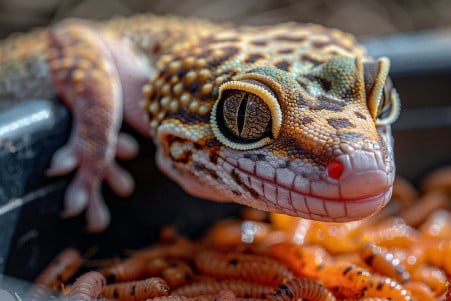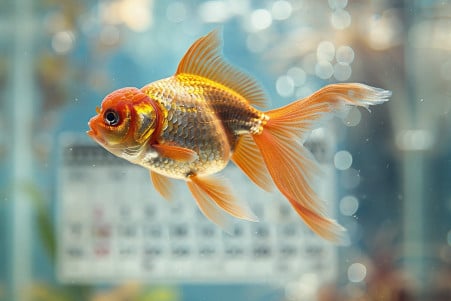Leopard Gecko Survival: How Long Can They Go Without Food?
2 March 2024 • Updated 2 March 2024

Leopard geckos’ tails are not just for show; they play a crucial role in survival. Leopard geckos can survive without food for 10 days to two weeks by utilizing the fat reserves stored in their tails. However, for optimal health, it is recommended that they are fed regularly and a veterinary consultation is sought if they refuse food or exhibit weight loss.
In our exploration of leopard gecko survival without food, we will examine herpetological research, dietary studies, and physiological analyses to illuminate their remarkable fat storage capabilities. We will also consider behavioral science to explain their adaptations during periods of food scarcity. This varied approach will not only reveal how long leopard geckos can go without eating but will also provide a comprehensive understanding of their needs and care.
How long can a leopard gecko go without eating?
Leopard Gecko Diet
Leopard geckos are insectivores, which means they eat live insects. According to Zen Habitats, leopard geckos have different feeding schedules based on their age. Juveniles should be fed daily, while adults with fat stored in their tails can be fed every five days. The recommended portion size for optimal health is 2 insects per inch of the gecko’s length, or however much they can eat in 15 minutes.
Before feeding, it’s important to gut-load the feeder insects to make sure they’re as nutritious as possible. ExoticDirect suggests a combination of leafy greens and commercial gutload diets to make sure the insects are as healthy as possible. In addition to gut-loading, it’s also important to dust the insects with calcium powder, especially for geckos that don’t have UVB lighting, to prevent metabolic bone disease, according to ReptiFiles.
It’s highly recommended that you don’t feed your leopard gecko wild-caught insects because of the potential risks of disease and pesticide exposure. It’s important to follow the proper diet for leopard geckos because an improper diet can lead to serious health issues. Following these dietary guidelines will help ensure that these hardy reptiles live long, healthy lives.
Leopard Gecko Tail Fat Storage: A Survival Mechanism
In addition to helping with balance and communication, the leopard gecko’s tail has another important function: fat storage. According to a paper by Anthony P. Russell that was published in PubMed, leopard geckos use their tails to store fat, and this fat storage is especially important when food is scarce because it acts as an emergency energy source.
This is especially true in the regenerated tails of juveniles, which store more fat than the original tails and may help them grow and reproduce.
In addition to fat storage, leopard geckos have biological adaptations that help them survive when food is scarce. According to ScienceDirect, leopard geckos synthesize Vitamin D3, which is important for regulating calcium and phosphorus, through UVB radiation, which is important for bone health and metabolism. Even when their food intake is reduced, leopard geckos can maintain their vitamin and mineral levels because of their physiological adaptations.
These adaptations demonstrate the complex equilibrium that exists in these resilient animals. While leopard geckos can endure periods of food scarcity through fat storage and vitamin and mineral maintenance, it also reveals how survival mechanisms can be closely connected to overall health.
Potential Dangers of Long-Term Fasting in Leopard Geckos
Although leopard geckos are able to survive periods of fasting by using their tail fat stores, there are potential dangers to this practice. A study published in PubMed by Marshall D. McCue found that long-term fasting alters the isotopic composition of reptilian tissues. Specifically, fasting results in an enrichment of 15N in excreta and a depletion of 13C, which may indicate changes in tissue composition as the body shifts to different energy sources.
Physiological responses to fasting have been observed in a variety of reptiles and snakes. These ectothermic, or cold-blooded, animals show that long-term fasting can lead to organ-specific metabolic prioritization and tissue remodeling. As noted in the Journal of Experimental Biology, this adaptive response is accompanied by a significant reduction in metabolic rate, up to 72% in some species, which enables snakes to conserve energy during long periods of fasting.
Yet, for leopard geckos, long-term fasting may result in non-recoverable damage, especially to muscle tissues and internal organs that aren’t prioritized for metabolic conservation.
Because leopard geckos rely on their fat stores during fasting, it’s important to understand the line between survival adaptation and potential damage to their health. This is also important to know because it emphasizes the importance of consistently monitoring their hydration to ensure their health, especially during fasting periods.
Why Water Is So Important for Leopard Gecko Survival
Water is important for leopard geckos, especially when they’re not eating, because it’s so important for their overall health. Dehydration can impact a leopard gecko’s ability to thermoregulate, which is the way they maintain their body temperature.
A study in PLoS One found that dehydrated lizards, which included species similar to leopard geckos, decrease their activity and change their thermoregulatory behaviors, including spending more time in cooler areas and hiding, which could impact their survival and fitness.
To make sure leopard geckos are getting enough water, you should have a shallow water dish on the cool side of their enclosure to prevent drowning and help with thermoregulation, according to The Pet Enthusiast.
In addition, you should change the water daily to keep it clean and free of contaminants. Even when they’re not eating, water is still important; leopard geckos can only go about two days without water before they become dehydrated, which can lead to serious health problems or death.
If leopard geckos don’t get enough water, even when they’re not eating, it can have serious consequences, which shows that water’s role in their diet goes beyond just providing nutrition. As leopard geckos go through periods of not eating, it can also be interesting to see how they respond behaviorally, such as by becoming less active, which can show just how adaptable they are.
Behavioral Changes: How Leopard Geckos Adapt to Scarcity
Leopard geckos have been shown to exhibit a variety of behaviors that help them survive when food is scarce. According to Science.gov, a study on the thermoregulatory behavior of leopard geckos found that the lizards actively sought out warm shelters during the day to store up heat for their nocturnal activities.
In times of food scarcity, leopard geckos may change their behavior, including potentially reducing the time they spend near heat sources to conserve energy.
The ways in which leopard geckos adapt to ensure their survival are a clear demonstration of their ability to change in response to their environment. One of the most common ways leopard geckos adapt to scarcity is by reducing their activity levels, as shown in a study that Science.gov references, which helps them conserve energy when resources are limited.
These changes in behavior are indirect evidence of leopard geckos’ ability to survive periods of fasting and provide important information about their resilience.
While these adaptive behaviors are important when leopard geckos are experiencing a period of fasting, they also highlight the importance of understanding leopard geckos’ natural behaviors to ensure their well-being in captivity. For leopard gecko owners, it’s important to be aware of these behaviors and adjust their care as needed to ensure leopard geckos’ well-being and longevity.
Final Thoughts: Leopard Gecko Resilience and Health
Leopard geckos have evolved to store fat in their tails, which allows them to survive without food for up to two weeks. This is evidence of their resilience and helps ensure their survival during times of scarcity.
At the same time, it’s important for pet owners to make sure they are feeding and monitoring their leopard geckos regularly to ensure their health. The gecko’s natural ability to go without food for a period of time should not be seen as a reason to skip proper care but as a sign of their impressive adaptability.
Responsible pet owners need to be aware of leopard geckos’ dietary requirements, the importance of water, and the impact of starvation on their health. It’s important to make sure that leopard geckos are getting a well-rounded diet that includes all of the necessary nutrients and to make sure that any signs of health problems are addressed as soon as possible.
While we marvel at the adaptability of leopard geckos, we also need to make sure that we are taking care of them properly so that they can continue to thrive and be healthy in the face of adversity.


